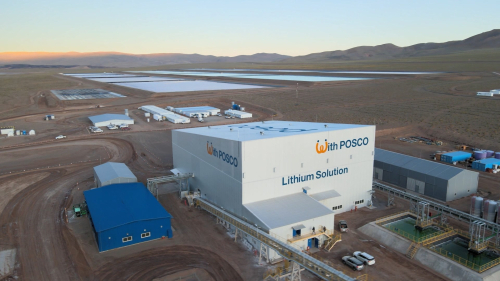Energy & Critical Metals
POSCO begins construction of S Korea’s first lithium hydroxide plant
POSCO Holdings recently began construction at the Yulchon 1st Industrial Complex in Jeollanam-do (South Jeolla Province, S. Korea) of the country’s first…

POSCO Holdings recently began construction at the Yulchon 1st Industrial Complex in Jeollanam-do (South Jeolla Province, S. Korea) of the country’s first lithium hydroxide plant, which will produce secondary battery materials using lithium produced from brine in Argentina.
We will enhance our global competitiveness in lithium and other mineral resources and contribute to the development of domestic industries, including the secondary battery sector, by leading the localization of materials.
—POSCO Group CEO Jeong-woo Choi
The new lithium factory is anticipated to have an annual production capacity of 25,000 tons of lithium hydroxide—sufficient for manufacturing approximately 600,000 electric vehicles. The total investment for the project is estimated at KRW 575 billion (US$443 million), and the factory is expected to be fully operational by 2025.
POSCO Pilbara Lithium Solution, a wholly-owned subsidiary of POSCO Holdings, will be responsible for the financing, construction, and operation of the plant.
The establishment of the lithium hydroxide plant is part of POSCO Holdings’ investment in Argentina’s lithium resources, which was announced in October last year. (Earlier post.) The initial stage of the production process, which involves producing lithium carbonate, the raw material for lithium hydroxide, will be conducted at a salt lake in Argentina owned by POSCO Holdings. The subsequent production of lithium hydroxide will take place in South Korea.
In 2018, POSCO Holdings acquired a package of tenements from Galaxy Resources in the Salar de Hombre Muerto in Argentina in order to secure lithium preemptively. POSCO is currently working on the 25,000-ton scale of the initial phase of lithium-from-brine plant in Argentina.
POSCO developed its own extraction technology for lithium in 2010. A pilot plant was manufactured in South Korea in 2017 with a capacity of 2,500 tons / year of lithium; this was then brought to and installed in Argentina.
POSCO Group’s lithium brine demo plant in Argentina.
Hombre Muerto is recognized as one of the most desirable salars in South America, as it hosts the (i) highest lithium brine grades; (ii) lowest levels of impurities; and (iii) highest flow rates in Argentina. Hombre Muerto is Argentina’s longest producing salar, with Livent Corp having produced 20,000 tonnes/year of battery-grade lithium for over 25 years.
POSCO Holdings plans to expand salt lake lithium production in Argentina up to 100,000 tons by 2028 with additional investments.
In the meantime, POSCO Group is building a lithium ore factory of POSCO Pilbara Lithium Solution in the Yulchon Industrial Complex. It is also operating the POSCO Future M electrode material factory and POSCO HY Clean Metal used battery recycling factory with the aim to develop a production hub for battery materials.

Uranium Exploration Company Announces Additional Staking in the Athabasca Basin
Source: Streetwise Reports 12/22/2023
Skyharbour Resources Ltd. announced an update from its Canada-based Falcon Project along with additional…
Tesla Launches New Mega Factory Project In Shanghai, Designed To Manufacture 10,000 Megapacks Per Year
Tesla Launches New Mega Factory Project In Shanghai, Designed To Manufacture 10,000 Megapacks Per Year
Tesla has launched a new mega factory…
Giving thanks and taking stock after “a remarkable year”
An end-of-year thank you to our readers, industry colleagues and advertisers before Electric Autonomy breaks from publishing until Jan. 2
The post Giving…











